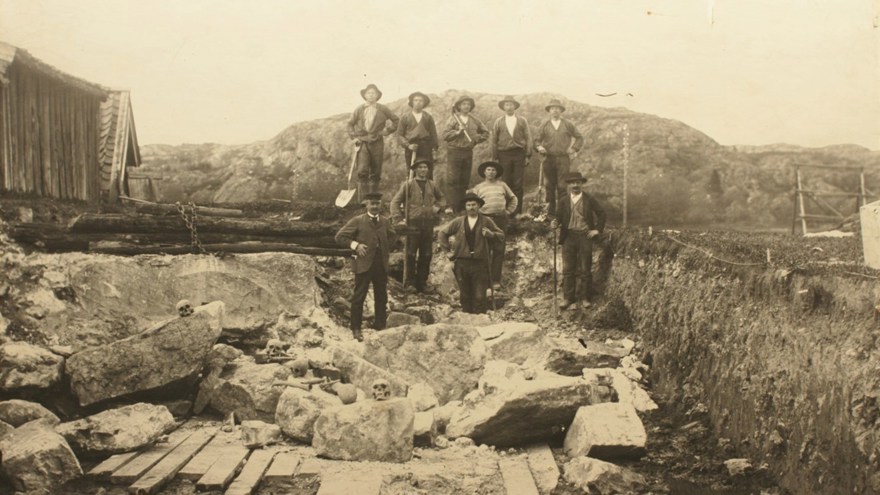The Archaeological History of Lödöse

Bang! The archaeological history of Lödöse began with a bang in the early 1900s. Not only that, parts of skeletons flew into the air and scared a group of railway workers who were blasting away a rock outcrop. This also marked the start of archaeological excavations in Lödöse.
The medieval written material from the town of Lödöse is very sparse. Despite the great interest in our ancient history during the 18th and 19th centuries, the medieval town was overlooked by historians of the time. As early as the 1910s, Carl af Ugglas stated that knowledge about Lödöse was primarily the domain of archaeology.
From Accident to Archaeological Discovery
The first archaeological investigation was mostly an accident. When they were blasting away what they thought was a rock outcrop for the railway construction in 1905, it was actually the remains of the choir and cemetery of St. Olaf's Church that they were blasting.
Skeleton parts are said to have flown, and the railway workers were reportedly frightened. They called the sheriff, who in turn sent for someone who could conduct an archaeological investigation, Principal Folke Nordin from Vänersborg. He interpreted the site as the remains of the hospital in Lödöse, mainly because the property designation is Spetalen.
Investigations in Connection with Gothenburg's 300th Anniversary
Eleven years later, a series of investigations and publications were initiated in preparation for Gothenburg's 300th anniversary. Among other things, they were to search for Gothenburg's roots. Investigating Gothenburg's first predecessor, Old Lödöse, fell to art historian Carl af Ugglas, and the investigations continued for four years from 1916. The aim was to get as comprehensive a picture of the town as possible, focusing on public buildings.
The investigations covered the Monastery Church, St. Olaf's Church, which was then thought to be St. George's Hospital. The outer bailey and part of the moat system of the castle were examined. The castle mound itself was built up with the beautiful merchant's villa that still stands there today. Parts of St. Peter's Church, a mill remnant in the north at the foot of Spetalberget, and parts of the harbor were also investigated. The town's buildings came second, with a few targeted excavations.
Due to the extensive material excavated, the publication was delayed by ten years. Still, "Lödöse, Old Lödöse – History and Archaeology" from 1931 remains the foremost work on the history of Lödöse town.
Lödöse Shipyard and the Medieval Town
During the 1930s, few excavations were made in Lödöse's medieval cultural layers. A boat remnant at Lödöse Shipyard and an antiquarian inspection near the medieval harbor were conducted by Philibert Humbla.
Municipal water and sewer lines were installed in Lödöse during the 1940s and 1950s. The archaeological supervision was not comprehensive, but a good understanding of the medieval town's extent was obtained. The archaeological work was mainly led by Harald Widéen.
New Discoveries as the Town Expands
In 1958, the major building expansion in Lödöse began with the construction of the Fornäng 1 property area. The antiquarian supervision was almost non-existent, and medieval building remains were excavated away with a caterpillar.
Two years later, in 1960, it was time for another intervention. Half of the area was preserved for archaeological supervision. The site was at Eriksgatan, which we call the telegraph site. Today, we believe that a post church stood here during the Middle Ages.
Finds Lead to a Museum
In the 1960s, the exploitation continued into the 1970s. First was the construction of Fornäng 2 in 1961, north of Långgatan in the central parts of the medieval town. The excavation leader during the first year was Per-Henrik Rosenström, who had an elementary school teacher from Lilla Edet, Rune Ekre, as an assistant during the first summer.
The 1961 excavation yielded an astonishing amount of finds and building remains, leading to discussions about building a museum. Four years later, the museum became a reality, located in the basement of the apartment building, Fornäng 2.
260 Archaeological Investigations Later
The exploitation of Lödöse continued with several archaeological investigations as a result. Often in the late 1960s and early 1970s, several archaeological investigations could be ongoing simultaneously. Archaeologists were assisted by people involved in various labor market support programs.
Apart from water and sewer leaks and a few research investigations, the last major excavation in Lödöse was in 1989. It was the expansion of the parish hall.
Today, with over 260 investigations and inspections conducted, we have a good picture of what the medieval town looked like. Many of the medieval artifacts found in the ground have also attracted great attention in Sweden and internationally. Not least the coins and minting history, the rich occurrence of pilgrim badges, glass production, and ceramic activities.
New Knowledge & New Questions
There are still many questions, especially about the oldest Lödöse, and new questions and findings emerge as the material is processed. What will the picture of medieval Lödöse look like in ten years?






